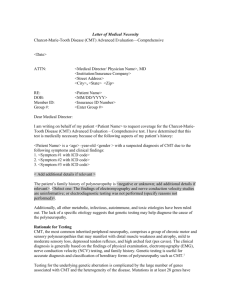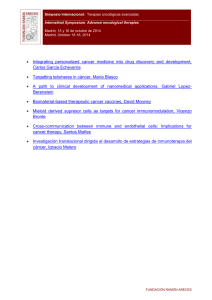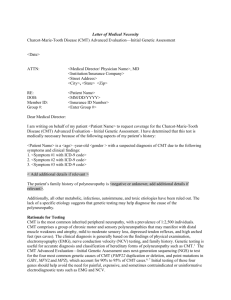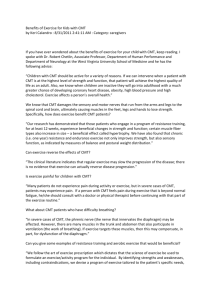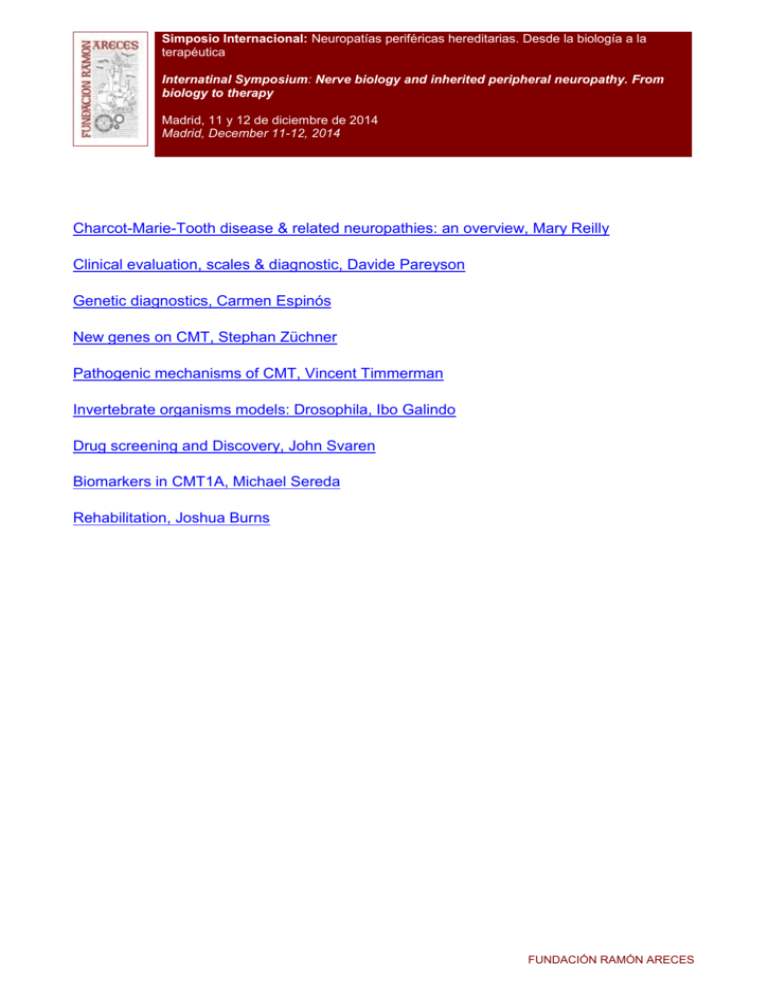
Simposio Internacional: Neuropatías periféricas hereditarias. Desde la biología a la
terapéutica
Internatinal Symposium: Nerve biology and inherited peripheral neuropathy. From
biology to therapy
Madrid, 11 y 12 de diciembre de 2014
Madrid, December 11-12, 2014
I
Charcot-Marie-Tooth disease & related neuropathies: an overview, Mary Reilly
Clinical evaluation, scales & diagnostic, Davide Pareyson
Genetic diagnostics, Carmen Espinós
New genes on CMT, Stephan Züchner
Pathogenic mechanisms of CMT, Vincent Timmerman
Invertebrate organisms models: Drosophila, Ibo Galindo
Drug screening and Discovery, John Svaren
Biomarkers in CMT1A, Michael Sereda
Rehabilitation, Joshua Burns
FUNDACIÓN RAMÓN ARECES
Simposio Internacional: Neuropatías periféricas hereditarias. Desde la biología a la
terapéutica
Internatinal Symposium: Nerve biology and inherited peripheral neuropathy. From
biology to therapy
Madrid, 11 y 12 de diciembre de 2014
Madrid, December 11-12, 2014
Charcot-Marie-Tooth disease & related neuropathies: an overview, Mary Reilly
Charcot Marie Tooth disease (CMT) and the related neuropathies are a clinically and
genetically heterogeneous group of disorders which most commonly present with a length
dependent motor and sensory neuropathy often accompanied by foot deformity. Over the
last two decades and especially in the last 5 years with the development of affordable next
generation sequencing techniques, there have been rapid advances in the identification of
the causative genes with over 80 genes now being described. Many of the causative
genes for the axonal form of CMT (CMT2) remain to be identified. One interesting
discovery with the identification of the latest causative genes is that genes that were
traditionally thought to cause other disorders such as Hereditary Spastic Paraparesis
(HSP) e.g. Atlastin and REEP1, are now occasionally described to cause an inherited
neuropathy such as Hereditary Sensory Neuropathy (HSN) or distal Hereditary Motor
Neuropathy (HMN) respectively.
A further consequence of the introduction of next generation sequencing to diagnostic
practise is the difficulty in validating whether a mutation is pathogenic or not. With multiple
genes being screened together, there are often many potential mutations in many genes
identified and with the current lack of easily available functional analysis of genes it can be
challenging to decide which mutation is the causative one. The same problem arises in
identifying the causative gene using whole exome sequencing when looking for new
genes.
Finally we still have no effective therapies for CMT or the related disorders. Two of the
major challenges to developing therapies are the very slow and usually not life threatening
progression of the disease with a need therefore for very safe therapies and the difficulty in
identifying sensitive and responsive outcome measures for clinical trials.
This overview will cover these areas especially the consequences of next generation
sequencing for the field and the progress in therapy development.
VOLVER/RETURN
FUNDACIÓN RAMÓN ARECES
Simposio Internacional: Neuropatías periféricas hereditarias. Desde la biología a la
terapéutica
Internatinal Symposium: Nerve biology and inherited peripheral neuropathy. From
biology to therapy
Madrid, 11 y 12 de diciembre de 2014
Madrid, December 11-12, 2014
Clinical evaluation, scales & diagnostic, Davide Pareyson
The diagnostic approach to the diagnosis of CMT is becoming more and more complicated
as the associated gene number increases and the clinical characteristics of the different
CMT types greatly overlap. The availability of next generation sequencing (NGS)
techniques has improved the diagnostic yield and at the same time makes it fundamental
to well characterize the CMT patients’ phenotype to interpret NGS results. Careful clinical
evaluation of patients is therefore still fundamental, and need to be completed by the
assessment of inheritance pattern and of nerve conduction studies (NCS). It is important to
look for peculiar clinical features that may still be specific for certain CMT subtypes, such
as optic atrophy, glaucoma, vocal cord palsy, pyramidal tract signs/spastic paraplegia, foot
and hand ulcers, autonomic dysfunction, learning difficulties, predominant upper limb
involvement, differences in hand musculature involvement. Nerve biopsy, now limited to
selected cases, may reveal specific myelin (i.e., myelin outfoldings) or axonal (e.g., giant
axons) changes. Cellular and animal model studies are demonstrating the therapeutic
potential of a series of compounds making it important clinical trial readiness. However,
the experience with ascorbic acid trials revealed the difficulties in translation from animals
to patients and in detecting intervention efficacy, owing to slow disease progression. We
therefore need to develop responsive outcome measures. The ascorbic acid trial in Italy
and UK showed the limits of the CMTNS and the potentiality of foot dorsiflexion myometry
(the most sensitive-to-change measure of the trial). Clinical research led to develop an
updated version of the CMTNS, a novel paediatric scale (CMTPedS) based on clinimetric
methods, and to test outcome measures used in other disorders (activity monitors, 6
Minutes Walking Test). Exploration of surrogate paraclinical outcome measures include
studies on computerised gait analysis, quantitative MRI, and biomarkers. We measured
mRNA PMP22 levels in skin biopsies from 46 patients recruited in the ascorbic acid trial at
study entry and end of study: we found no change over two years and no correlation with
disease severity. The skin biopsy approach allows testing other potential biomarkers.
VOLVER/RETURN
FUNDACIÓN RAMÓN ARECES
Simposio Internacional: Neuropatías periféricas hereditarias. Desde la biología a la
terapéutica
Internatinal Symposium: Nerve biology and inherited peripheral neuropathy. From
biology to therapy
Madrid, 11 y 12 de diciembre de 2014
Madrid, December 11-12, 2014
Genetic diagnostics, Carmen Espinós
The Charcot-Marie-Tooth (CMT) disease o hereditary motor sensory neuropathy (HMSN)
is characterized by a wide genetic heterogeneity: more than 50 genes have been reported
and this number continues growing. The CMT disease is usually split up into two main
groups according to electrophysiological and histopathological criteria, demyelinating CMT
and axonal CMT. The CMT1A duplication, which affects the PMP22 gene, is the more
common cause of CMT and represents approximately the 80% of demyelinating CMT
cases. Other frequent genes are MPZ, GJB1, PMP22 and SH3TC2 related to
demyelinating CMT, and MFN2, GDAP1 and GJB1 involved in axonal CMT. The remaining
genes associated with CMT represent very low percentages. Thus, the molecular
diagnosis is complicated and different approaches can be applied: (1) Analysis of the most
frequent genes or candidate genes, which consists of the analysis gene-by-gene using
Sanger sequencing. This approach is easy to perform, although also time-consuming. (2)
Panel of genes that implies the analysis of all the known genes involved in this group of
disorders using massive sequencing. This is an efficient method due to the number of
analyzed genes, but the subsequent informatic analysis is difficult due to the high number
of detected changes and its possible pathological significance. (3) Whole exome
sequencing (WES) or whole genome sequencing (WGS) based on massive sequencing.
The complexity of these two approaches makes that by now they are performed within
research projects and mainly, in clinical cases of interest with the aim to identify new
genes related to this group of neuropathies.
VOLVER/RETURN
FUNDACIÓN RAMÓN ARECES
Simposio Internacional: Neuropatías periféricas hereditarias. Desde la biología a la
terapéutica
Internatinal Symposium: Nerve biology and inherited peripheral neuropathy. From
biology to therapy
Madrid, 11 y 12 de diciembre de 2014
Madrid, December 11-12, 2014
New genes on CMT, Stephan Züchner
Genome-wide sequencing techniques have transformed and greatly enhanced our
approach to novel disease gene identification and diagnostics. In the CMT field alone a
novel gene is now identified every single month. The consequences are exciting for
molecular studies and development of therapeutic targets, yet the diagnostic conundrum of
genetic variants of unknown significance is at least temporarily increasing. This
presentation will summarize these recent developments, opportunities and challenges
based on our experiences in CMT genetic research studies, namely the Inherited
Neuropathy Consortium. I will discuss ways forward to overcome current limitations and
towards an increasingly powerful genetic diagnostic toolbox.
VOLVER/RETURN
Pathogenic mechanisms of CMT, Vincent Timmerman
Charcot-Marie-Tooth (CMT) neuropathies comprise a group of monogenic disorders
affecting the peripheral nervous system. CMT is characterized by a clinically and
genetically heterogeneous group of neuropathies, involving all types of Mendelian
inheritance patterns. Over 1,000 different mutations have been discovered in 80 diseaseassociated genes. Genetic research of CMT has pioneered the discovery of genomic
disorders and aided in understanding the effects of copy number variation and the
mechanisms of genomic rearrangements. Clinical, molecular genetic and functional
studies suggest for common pathomechanisms and gene networks for peripheral nerve
degeneration. The most remarkable group of genes are those coding for three small heat
shock proteins (HSPBs). Although regulated by stress, they are constitutively expressed
FUNDACIÓN RAMÓN ARECES
Simposio Internacional: Neuropatías periféricas hereditarias. Desde la biología a la
terapéutica
Internatinal Symposium: Nerve biology and inherited peripheral neuropathy. From
biology to therapy
Madrid, 11 y 12 de diciembre de 2014
Madrid, December 11-12, 2014
and responsible for quality control and protein folding. The HSPBs are not only molecular
chaperones but also involved in many essential cellular processes such as apoptosis,
autophagy, splicing, cytoskeleton dynamics and neuronal survival. We reported that
tubulin differentially interacts with mutant HSPB1. This anomalous binding leads to the
stabilization of the microtubule network. We also found that mutations in HSPB1 disrupt
the neurofilament network and cause their aggregation. Altogether, specific mutations in
the small heat shock proteins affect the axonal transport via induced hyperphosphorylation
of neurofilaments and stabilization of the microtubule network. Both pathomechanisms can
be targeted by drugs in experimental models and may open possibilities for future
treatment strategies.
VOLVER/RETURN
Invertebrate organisms models: Drosophila, Ibo Galindo
Rare diseases are counted in the thousands, and the number of known causative genes
increases continuously. In contrast, the human and economic resources that we can
devote to them do not grow at the same pace, and this is forcing us to find new strategies
to optimize these resources. One such novel strategy, which can be of great help, is to
identify non-vertebrate animal models to study those biological mechanisms that are well
conserved. The fruit fly, Drosophila melanogaster, has been used in research in genetics
since the early 20th century, and now it is widely used to study several human pathologies,
since we share with the fly molecular and cellular mechanisms in cell physiology,
neurobiology and genetics.
Regarding CMT research, there are already Drosophila models to understand the
mutations in genes related with the disease: Gars, Yars, Rab7, MFN2 and GDAP1, this
FUNDACIÓN RAMÓN ARECES
Simposio Internacional: Neuropatías periféricas hereditarias. Desde la biología a la
terapéutica
Internatinal Symposium: Nerve biology and inherited peripheral neuropathy. From
biology to therapy
Madrid, 11 y 12 de diciembre de 2014
Madrid, December 11-12, 2014
last one carried out by our group. In CMT research it is important to have animal models to
complement the studies in cellular models, since we need to study events such as
synaptic communication between the neuron and the muscle or age-dependent
neuromuscular degeneration, which cannot be reproduced in isolated cells. From these
studies we will be able to develop models that reproduce the molecular lesion present in
the patients in order to identify new biomarkers and to develop new therapies.
VOLVER/RETURN
Drug screening and Discovery, John Svaren
The most common cause of Charcot-Marie-Tooth (CMT) disease is a gene duplication
resulting in three copies of the gene encoding the major myelin protein, Peripheral Myelin
Protein 22 (PMP22). The associated neuropathy has been classified as CMT1A, and work
by several groups have established that rodent models with PMP22 overexpression
recapitulate many aspects of the human disease. Moreover, reduction of PMP22 levels
has been shown to resolve many aspects of the peripheral neuropathy. In previous work,
development of therapeutic approaches for CMT had not employed chemical genomic
approaches to identify potential therapeutic compounds using unbiased screens of
chemical libraries. Therefore, we have developed a series of drug screening assays to
identify compounds that selectively reduce PMP22 expression to develop effective
treatments for CMT1A. Our latest generation of assays has used recently developed
techniques of genome editing to insert reporter genes into the endogenous PMP22 locus
in a Schwann cell line that expresses high levels of PMP22. In collaboration with the group
of Dr. Inglese at the National Center for Advancing Translational Sciences/NIH, these
assays have been used to screen chemical libraries using a sensitive and powerful drug
FUNDACIÓN RAMÓN ARECES
Simposio Internacional: Neuropatías periféricas hereditarias. Desde la biología a la
terapéutica
Internatinal Symposium: Nerve biology and inherited peripheral neuropathy. From
biology to therapy
Madrid, 11 y 12 de diciembre de 2014
Madrid, December 11-12, 2014
screening protocol that employs dose-dependent screening. In addition, follow-up assays
and rodent models are being used to evaluate the effectiveness of new compounds.
Overall, recent genomic studies have uncovered a number of disease states, like CMT1A,
that are caused by copy number variants. Therefore, the use of genome edited assays to
identify modulators of gene expression levels should be applicable to many other gene
dosage disorders, as well as other types of CMT.
VOLVER/RETURN
Biomarkers in CMT1A, Michael Sereda
Despite its monogenetic cause, patients with CMT1A display a marked interindividual
variability of disease severity. The underlying reason for this variability is largely unknown
and epigenetic factors have been discussed. At present, the assessment of the individual
disease severity in patients with CMT1A is performed solely by clinical and
electrophysiological examinations. In light of the slow disease progression, insensitive
outcome measures may increase the risk of false negative results in clinical trials and
biomarkers could add powerful tools to monitor therapeutic effects. Biomarkers may not
only serve as a sensitive surrogate marker of clinical severity, but may also identify
responders to a putative therapy. CMT rats carrying additional copies of the Pmp22 gene
recapitulate the striking disease variability observed in patients with CMT1A. In a proof of
principle study, we have demonstrated that the expression levels of selected genes in
sciatic nerve and skin tissue can be utilized to measure and predict the disease severity in
CMT rats. Importantly, we validated these disease severity markers in skin biopsies of 46
FUNDACIÓN RAMÓN ARECES
Simposio Internacional: Neuropatías periféricas hereditarias. Desde la biología a la
terapéutica
Internatinal Symposium: Nerve biology and inherited peripheral neuropathy. From
biology to therapy
Madrid, 11 y 12 de diciembre de 2014
Madrid, December 11-12, 2014
patients with CMT1A. At the moment, these and new markers are examined with regard to
disease progression within a large pan-European consortium in 277 CMT1A patients (83
from Germany, 56 from the Czech Republic, 50 from Spain, 27 from Belgium, 20 from the
UK, 17 from Italy, 15 from the USA und 9 from France). In the near future we hope to
provide the community with applicable biomarkers which in turn may accelerate the
development of a therapy for CMT1A.
VOLVER/RETURN
Rehabilitation, Joshua Burns
This presentation provides an overview of evidence-based rehabilitation strategies for
children and adults with Charcot-Marie-Tooth disease. Rehabilitation primarily focuses on
pain and disability associated with the cavus foot deformity, foot drop, ankle contracture,
chronic ankle instability, muscle cramps, sensory loss, impaired balance as well as hand
and upper limb dysfunction. Strategies include stretching and strengthening exercises,
orthotic and footwear therapies, rehabilitation after orthopaedic surgery and surveillance
for hip dysplasia to increase each patient’s ability to perform activities of daily living and
improve their quality of life.
VOLVER/RETURN
*Todos los derechos de propiedad intelectual son del autor. Queda prohibida la reproducción total o parcial de la obra
sin autorización expresa del autor.
© FUNDACIÓN RAMÓN ARECES. Todos los derechos reservados.
*All intellectual property rights belong to the author. Total or partial reproduction of the work without express permission
of the author is forbidden. © FUNDACIÓN RAMÓN ARECES. All rights reserved.
FUNDACIÓN RAMÓN ARECES




